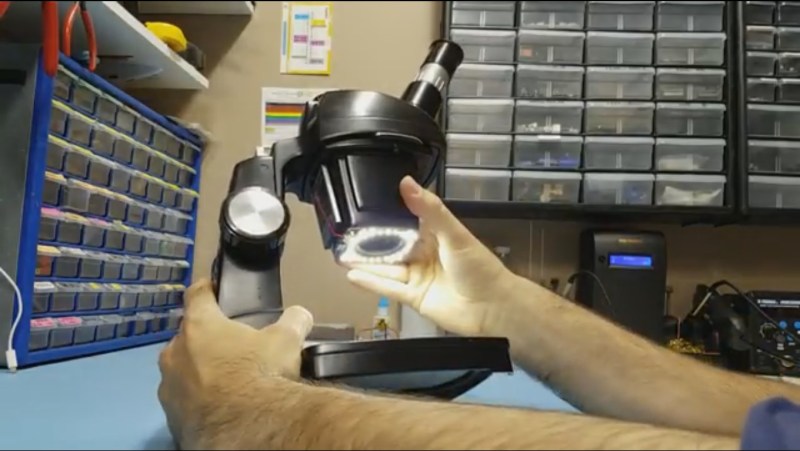When [Felix Rusu], maker of the popular Moteino boards which started life as wireless Arduino compatibles, says he’s made a wireless ring light for his SMD microscope, we redirect our keystrokes to have a look. Of course, it’s a bit of wordplay on his part. What he’s done is made a new ring light which uses a battery instead of having annoying wires go to a wall wart. That’s important for someone who spends so much time hunched over the microscope. Oh, and he’s built the ring light on a rather nice looking SMD board.
The board offers a few power configurations. Normally he powers it from a 1650 mAh LiPo battery attached to the rear of his microscope. The battery can be charged using USB or through a DC jack for which there’s a place on the board, though he hasn’t soldered one on yet. In a pinch, he can instead power the light from the USB or the DC jack, but so far he’s getting over 6 hours on a single charge, good enough for an SMD session.
The video below shows his SMD board manufacturing process, from drawing up the board in Eagle, laser cutting holes for a stencil, pasting, populating the board, and doing the reflow, along with all sorts of tips along the way. Check it out, it makes for enjoyable viewing.
Here’s another microscope ring light with selectable lighting patterns for getting rid of those pesky shadows. What features would make your SMD sessions go a little easier?
















Nice practical little build, the reason it lasted more than 6 hours on an even smaller than estimated battery, is likely because as the battery voltage drops so does Vf and power through the LED’s.
Nice!
I went for a simple ac powered ring-light for my similar Baush&Lomb microscope. I documented it here:
http://transistor-man.com/bausch_lomb_microscope_light.html
The build is great! may have to send out a pcb and upgrade!
Looks really good.
Next step: Add a polarizer sheet on the LEDs and another polarizer filter on the objective lens, rotated 90 degrees. This eliminates the specular reflections off the work, greatly improving the view.
Replacement polarizer sheets for cell phone displays are a quick and easy source of excellent polarizer for the LEDs, but for the lens you get better results using a good quality adjustable photographic polarizing filter. You’ll want a linear polarizer. if you use a circular polarizer it will still work if you take care to face it in the correct direction.
Awesome tip! I’ve gotta try that one out